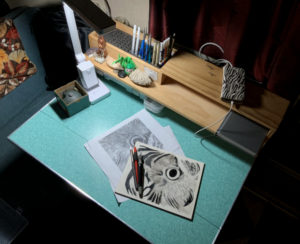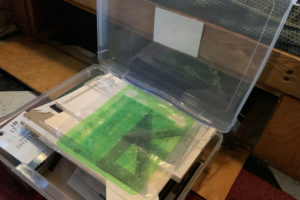The most important thing about creating 2D art with traditional media in a super small space is being organized, but not in the way you might think. Organization of materials and related items is a given, especially when full-timing. The real challenge is prioritizing your projects and having their order documented in an organized fashion, because those priorities are the key to knowing what materials you need to have readily at hand in your rig, packed for later use, or stored in your tow vehicle.
I decided early this autumn that when we arrived in warmer climes my main objective would be turning my current supply of canvas board, scratchboard and much of my paper stock into salable art works. I packed the smallest and most easily converted of these surfaces first, followed by the materials I use to work on them: Graphite, colored pencils, gouache, watercolor, ink and all associated tools. Since I was not going to be working with my oil paints, all of those were packed away securely in our storage unit, along with their associated canvas and gesso board, and will be picked up on our way back to our summer quarters.
 The drop leaf table at the front of the Airstream is my drawing table, and it is approximately 2.5” square. It is precious space and I’m necessarily choosy about what lives on it. The media I use regularly need a way to be at hand without taking up all of my table space or being stacked in a way that makes materials at the bottom inaccessible. The solution for me is a small shelving unit that consumes the back quarter of my table and enables me to shelve, rather than stack, the bins where my materials are stored. It also allows for me to stage graphite and ink pens in a foam holder for ease of use until a project is completed. Affixed to the back of the shelf is a power strip which serves as my charging station for laptops, tablets and phones, and power source for my Ott Lite desk lamp. And since no studio is complete without a bit of decor, I use the smallest portion of the shelf for it.
The drop leaf table at the front of the Airstream is my drawing table, and it is approximately 2.5” square. It is precious space and I’m necessarily choosy about what lives on it. The media I use regularly need a way to be at hand without taking up all of my table space or being stacked in a way that makes materials at the bottom inaccessible. The solution for me is a small shelving unit that consumes the back quarter of my table and enables me to shelve, rather than stack, the bins where my materials are stored. It also allows for me to stage graphite and ink pens in a foam holder for ease of use until a project is completed. Affixed to the back of the shelf is a power strip which serves as my charging station for laptops, tablets and phones, and power source for my Ott Lite desk lamp. And since no studio is complete without a bit of decor, I use the smallest portion of the shelf for it.
 Paper and board stock are stored in bins beneath our front couch, along with other “craft” items (I crochet when I want a break … ), while colored pencils not currently in use are in a case in an overhead bin. My portable easel has a drawer in it where gouache and watercolors are stored, and it, in turn, is stored beneath the drop leaf table. I have recently begun using small jars for my rinse water. The small chopped garlic and ginger jars are the perfect size to travel with, have lids that make them easy to transport while full, and Paint Pucks (a brush cleaning solution I can’t recommend highly enough) fit in them beautifully. If you paint at all, especially while on the road, give this combo a shot. Seriously. It’s fantastic.
Paper and board stock are stored in bins beneath our front couch, along with other “craft” items (I crochet when I want a break … ), while colored pencils not currently in use are in a case in an overhead bin. My portable easel has a drawer in it where gouache and watercolors are stored, and it, in turn, is stored beneath the drop leaf table. I have recently begun using small jars for my rinse water. The small chopped garlic and ginger jars are the perfect size to travel with, have lids that make them easy to transport while full, and Paint Pucks (a brush cleaning solution I can’t recommend highly enough) fit in them beautifully. If you paint at all, especially while on the road, give this combo a shot. Seriously. It’s fantastic.
My digital studio tools are the most compact aspect of my studio space, and have dedicated carrying cases in which they are stored when not in use. Unless I am referring directly to reference files stored on it, there is no reason at all why my iPad needs to be on my table, or even on the shelf, if I’m working on a watercolor or graphite piece. When I do need that reference, I have a stand for it from CTA Digital that holds it above and away from my working surface. Designed for kitchen use, it is the perfect size for a small studio space, and folds down relatively flat for storage. If reference happens to be on one of my larger laptops, I have my Roost stand. When not in use, the Roost folds down to a size that can fit inside a paper towel roll. A friend who writes code for a living turned me on to it, and it’s been an incredible space saver.
Are you an artist who full-times in your RV? What are some of the ways you are using your small space to create your work? I’d love to hear from you and I look forward to seeing you down the road!